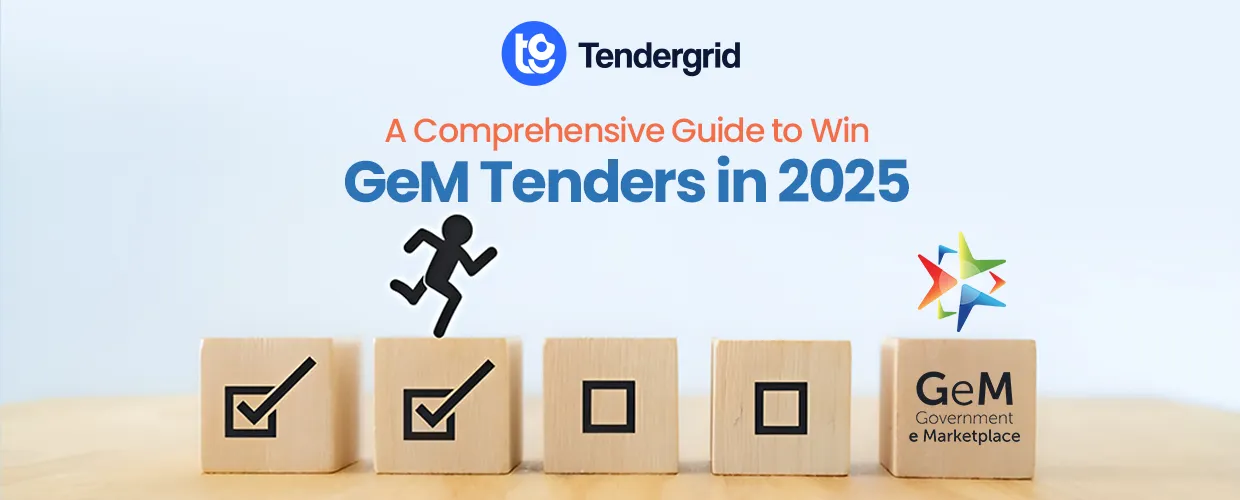GeM is an initiative by the Government of India to facilitate government departments, public sector undertakings, and other organizations to procure goods, works, and services online. GeM's mission is to facilitate easy public procurement, bypassing intermediaries, whether you sell products, works or offer services, knowing how to access GeM tenders is key to securing the big government tenders. Therefore, here in this Tender Grid guide you will get to know the necessary insights and strategies to help you navigate and succeed in the competitive GeM tender space.
Types of GeM Tenders
- Open Tenders: Any eligible vendor can participate.
- Limited Tenders: Only pre-approved vendors can submit bids.
- Reverse Auctions: Vendors compete to offer the lowest price, making it particularly important to have an effective pricing strategy.
- Direct Purchase: For low-value procurements, government departments may opt for direct purchase, bypassing the tender process but still sourcing products through the GeM platform.
Recent Trends Shaping the GeM Tender Industry
GeM encompasses hundreds of sectors, and each type of industry can look out for procurement opportunities on this platform. Here you will get to know the key sectors and industries that are trendsetters.
Key Sectors and Industries
-
Information Technology and Electronics: With the increasing demand for digital transformation in government organizations, IT-related government tenders are among the most common. These include hardware (computers, printers, etc.), software solutions, IT consulting, and even network services.
-
Health and Medical Equipment: GeM stands at a key position in regard to purchasing medical supplies and pharmaceuticals as well as in procuring hospital equipment.
-
Office and Stationery: Daily stationery supplies, such as papers and pens, and office furniture remain in constant demand.
-
Construction and Infrastructure: Large-size construction and civil works often have large projects, such as road construction, which the department purchases through GeM.
-
Defense and Security: In defense, most of the vendors require certifications to provide high-standard products.
-
Transport and Logistics: Vehicle supply, fuel, and logistics services
-
Education and Training: Educational institutions and government training centers regularly post government tenders for academic materials, e-learning platforms, training modules, and consultancy services.
-
Agriculture: Focus on agricultural technology, modern equipment, and fertilizers, making GeM an essential tool for suppliers in the agricultural sector.
Strategies for a Winning GeM Proposal
-
Transparency and Integrity : Make your proposal clear, concise, and straightforward. Be honest about your products, pricing, and certifications, as GeM emphasizes transparency.
-
Customization and Value-added Services : Highlight customization options or value-added services such as after-sales support or maintenance to meet specific government needs.
-
Leverage Technology to Your Advantage : Demonstrate how your IT services or technology products increase productivity, reduce costs, or improve service, leveraging themes of digital transformation.
-
Build Relationships with Key Tender Issuers : Attend government procurement events, workshops, and seminars to network with key players in the ecosystem. They provide valuable insights into upcoming government tenders and the buying patterns of different departments.
Building a Strong Reputation in the GeM Market
-
Ethical Practices : Building a solid reputation based on ethical practices is essential for long-term success in GeM tenders. Adhering to sustainability standards, offering high-quality products, and maintaining transparency in transactions will establish your credibility and improve your chances of securing future tenders.
-
Customer Relationship Management (CRM) : Maintaining strong relationships with both tender organizers and buyers is crucial. A robust CRM system will help you track interactions, improve communication, and ensure that you remain at the top of your mind when new tenders are published.
-
Transparency in Transactions : Clear communication regarding your gemstones' quality, pricing, and delivery schedules will enhance trust and foster long-term relationships. Transparent transactions reduce the risk of disputes and position you as a reliable supplier.
-
Post-Tender Feedback and Improvement : After each tender, seek feedback from the relevant government entities. Understanding where your proposal succeeded or fell short will help you continuously improve your offerings and strategy for future government tenders.
Challenges in GeM Tenders and How to Overcome Them
1. Intense Competition
GeM tenders attract numerous vendors, especially for popular products or services. To stand out, ensure that your bids are not only competitive in terms of pricing but also in quality, value-added services, and compliance.
2. Compliance with Government Regulations
Government procurement is highly regulated, and navigating the complex rules can be difficult for new vendors. To overcome this challenge, ensure that you are fully aware of the compliance requirements in the sector you’re bidding for and consider consulting with legal experts if needed.
3. Changing Tender Requirements
Government departments may change the specifications or conditions of a tender midway through the bidding process. Stay flexible and monitor updates regularly to ensure your bid remains aligned with the latest requirements.
Looking Ahead: Future Trends in GeM Tenders
As we move into 2025, emerging trends and sectors are going to shape the GeM tender landscape, and vendors will find this a great opportunity. Some of these emerging sectors, as seen, are directly aligned with the evolving priorities and development goals of India. Here are some of the key sectors that may see increased procurement activity and opportunities in GeM:
1. Digital Transformation: The government's demand for IT services, software, and automation tools will increase in line with digitalization. Vendors offering AI, cloud solutions, and tech consulting will have more opportunities.
2. Sustainability: Green procurement that will focus on green products, energy-efficient solutions, and sustainable materials will grow and be more preferred to vendors that offer green technologies.
3. Healthcare: The expansion of the healthcare sector will include medical equipment, pharmaceuticals, and health IT solutions, fueled by continued infrastructure development as well as post-pandemic needs.
4. Defense: Sustained growth in defense and security will drive procurement for advanced technologies, military equipment, and surveillance systems; it will provide opportunities for vendors specializing in these areas.
5. Infrastructure: The construction of roads and urban development projects shall sustain the drive for the demand for materials, machinery, and services that are required for civil engineering, thereby providing an upsurge for vendors within these categories.
6. Renewable Energy: With a push towards clean energy, demand for solar, wind, and energy storage solutions will rise, offering opportunities for vendors in renewable energy technologies.
7. Agriculture: The government is taking the initiative to modernize agriculture through technology by implementing modern farming technology such as drones, IoT devices, and precision farming solutions.
8. Education: Increasing focus on education and skill development will open opportunities for vendors offering e-learning platforms, educational materials, and digital classroom solutions.
9. Transport and Logistics: The government's infrastructure projects will increase demand for vehicles, logistics services, and transportation technologies, thus offering growth for related vendors.
10. Smart Cities: As India develops smart cities, opportunities will grow for vendors providing IoT solutions, renewable energy integration, and smart infrastructure technologies for urban areas.
11. Cybersecurity: With the increase in digital threats, the demand for cybersecurity services, including network protection, encryption, and cloud security, will increase across government departments.
12. Telecommunications: The 5G rollout and telecom infrastructure development will create demand for equipment, installation services, and tech solutions, offering opportunities in the telecom sector.
13. Waste Management: The increasing emphasis on sustainability will make waste management and recycling solutions, such as waste-to-energy technologies and recycling equipment, more in demand.
14. Increased Focus on Local Vendors (Atmanirbhar Bharat): The Indian government's push for self-reliance under the "Atmanirbhar Bharat" initiative is likely to propel local vendors and manufacturers through GeM tenders. Businesses that align their offerings with this initiative will likely have more opportunities in the future.
Seeking for GeM Tenders Online? Visit Tender Grid
Winning a GeM tender in 2025 requires more than just submitting a bid. It requires strategic preparation, an understanding of market trends, competitive pricing, transparency, and a commitment to delivering high-quality goods, works and services. By leveraging the insights and strategies outlined in this guide, you can increase your chances of securing government tenders and establishing a strong presence in India’s public procurement landscape.
To further enhance your chances, our platform provide valuable resources and real-time updates, helping you stay ahead in the competitive bidding process and ensuring you never miss a crucial opportunity. Thus, visit Tender Grid today for a comprehensive and user-friendly approach to accessing GeM tenders online.

